If you love coffee, then you must take a coffee tour in Costa Rica. Costa Rica produces some of the world’s highest quality coffee.
There are many coffee tours in Costa Rica, from full on plantation tours to roasting tours. The best coffee tours are the ones where coffee grows the best in Costa Rica, which are high elevation places such as the Central Valley (San Jose, Cartago, Heredia and Alajuela).
From San Jose, there are a few coffee tours to do but the easiest one to visit to experience the full plantation and process, is Doka Estate Coffee.
We visited Doka Estate Coffee and did their Doka Coffee Tour which is one of our favorite tours in Costa Rica.
This post has affiliate links which we may earn a small commission from if you choose to purchase, at no extra cost to you. Any prices listed may not reflect current pricing. It is the readers responsibility to research current pricing. Prices are quoted in USD. More info: Disclosure
Location
Doka Estate is 30 kilometers (19 miles) northwest from San Jose. It is about a 1 hour drive on a well paved road.
The Doka Estate Coffee Tour
Doka estate coffee tour is one of the oldest coffee plantations in the country. The family who owns and runs the plantation has been doing this for over 70 years! The estate is located up in the valleys of Alajuela with the perfect conditions to grow coffee: a cool climate of 17 to 28° Celsius (63 to 82° F) , fertile soil and a high altitude of 800 to 1600 meters (2624 to 5249 feet).
Their coffee tour takes you through the entire process from planting the coffee tree, picking cherries, roasting and making the Costa Rican way. It’s an extremely fun, educational, interactive and interesting tour for anybody who likes coffee.
Station one – the plants
Coffee comes from a plant that grows cherries with the coffee bean inside. If you drive along the Central Valley, you’ll likely see rows and rows of these coffee plants. Our guide showed us what a coffee plant looks like at 1 year, 2 year, 4 year and full grown. It takes quite awhile for these plants to develop and start producing cherries.
Coffee pickers measure their cherries by baskets. One basket weighs 28 pounds and a good coffee picker can pick up to 18 baskets a day! It’s not an easy job being out there in the sun 11 hours a day and they get paid around $3 USD per basket. Majority of the coffee pickers nowadays are from Nicaragua.
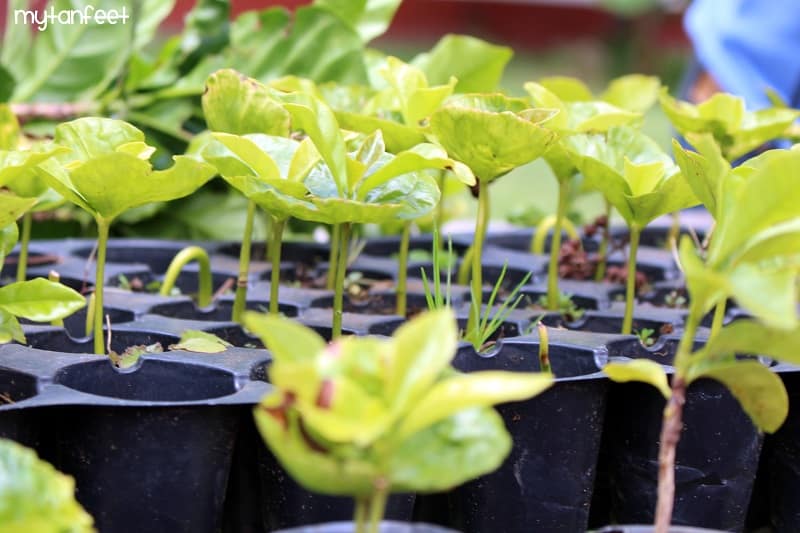
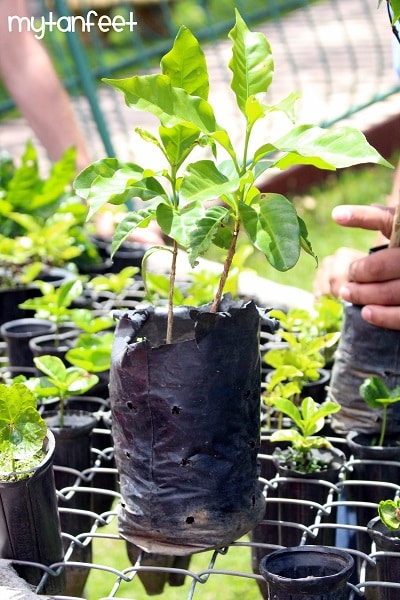
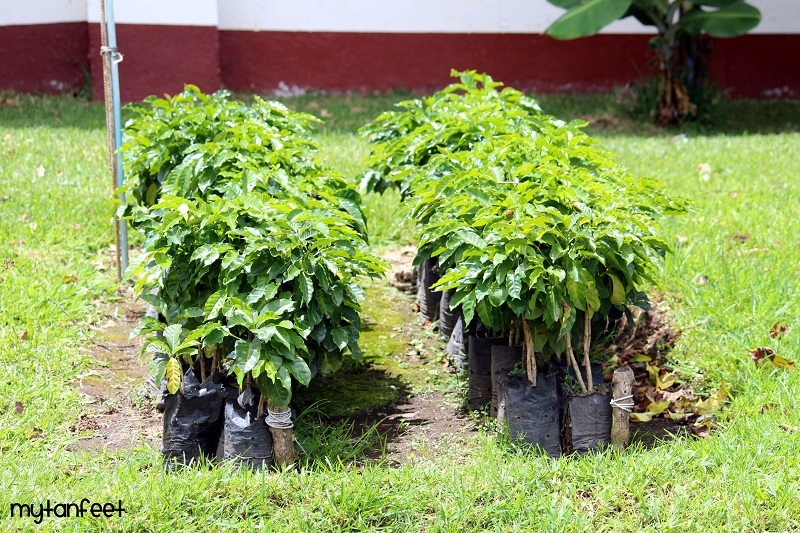
Station 2, 3 and 4 – Coffee Processing (Washing, Peeling, Fermenting and Drying)
This station is the oldest wet mill in the country and this is where the cherries are separated by quality using water. Low quality coffee floats and high quality coffee sinks. Most of the floaters are green unripe cherries or berries that have holes chewed by worms.
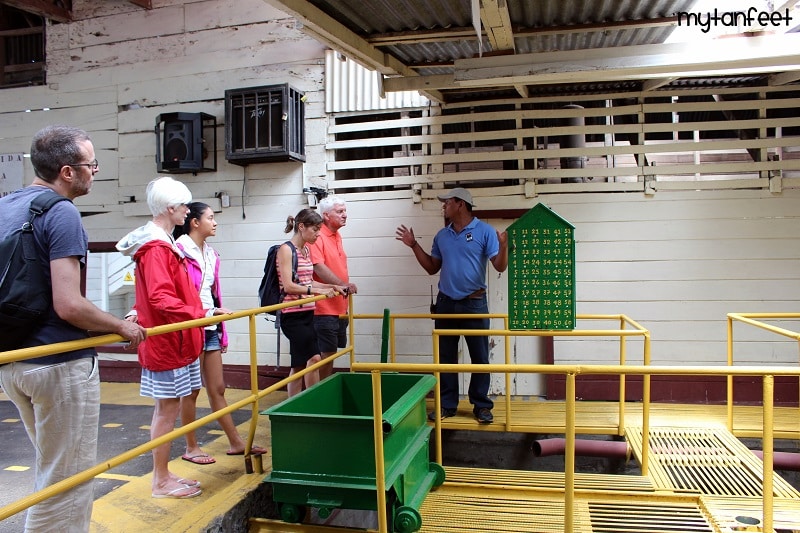
Unfortunately we came in the off season so the mill wasn’t working. Coffee picking season is from September to January-ish so we couldn’t see the process in action which would have been really interesting to see. The truck dumps the berries into the green container and the berries drop straight into the water.
Once they are separated by floaters and sinkers, the berries get carried into the next room where they get shelled and washed.
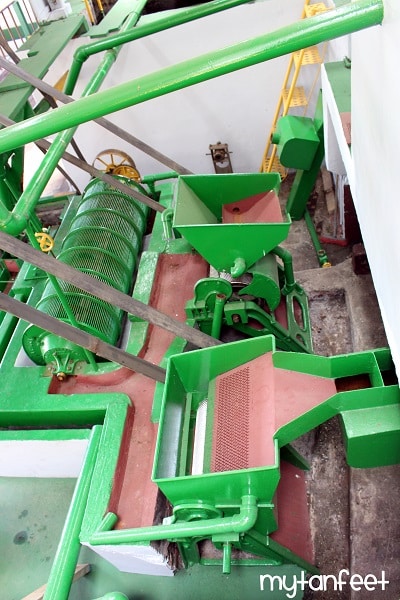
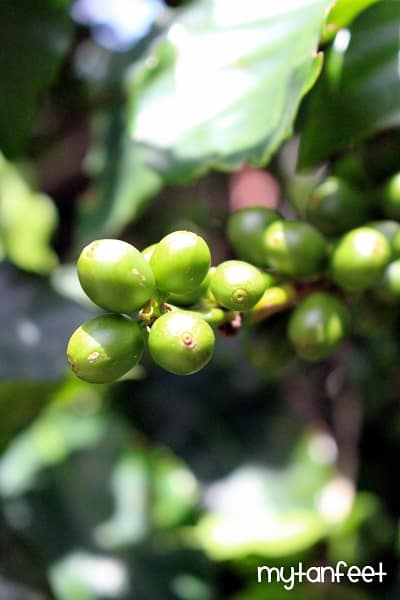
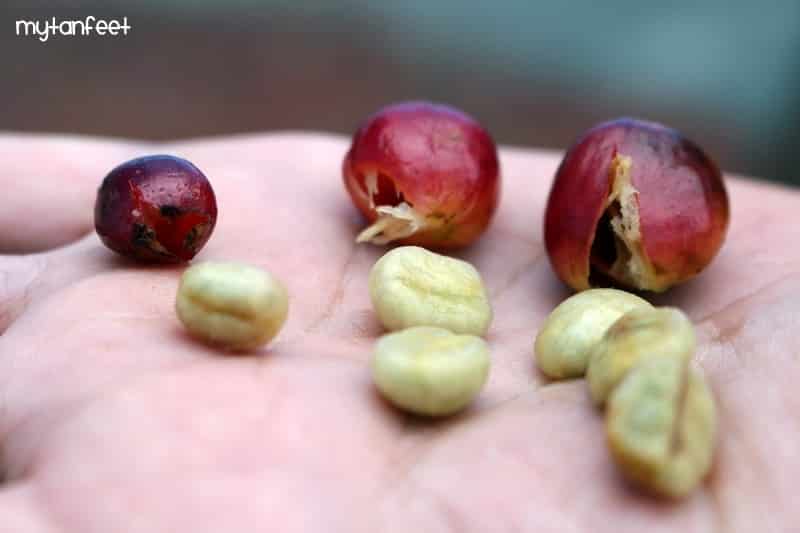
Next, they get directed into large holding areas to ferment in order to get rid of the sugar. After that, the beans need to be dried. There are two ways to dry the beans either by the sun or machine. Our guide told us that machine is faster but the quality and the flavor doesn’t turn out quite as good.
To hand dry, they rake out all the beans on a flat surface outside and sift through them every 45 minutes.
Station 5 – Storage
After the beans are dried, they go into storage and here you can find huge bags of coffee! They separate it out by quality which you can tell in the colors. At this point, you can peel the outside and find the coffee bean.
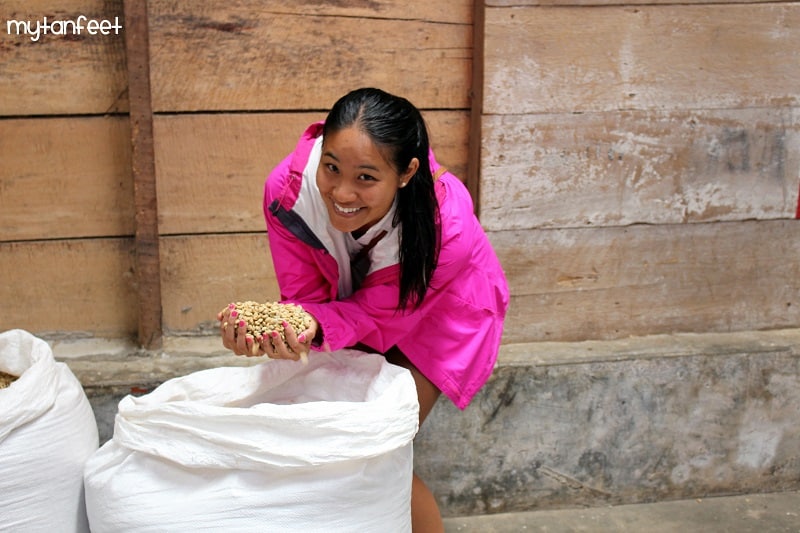

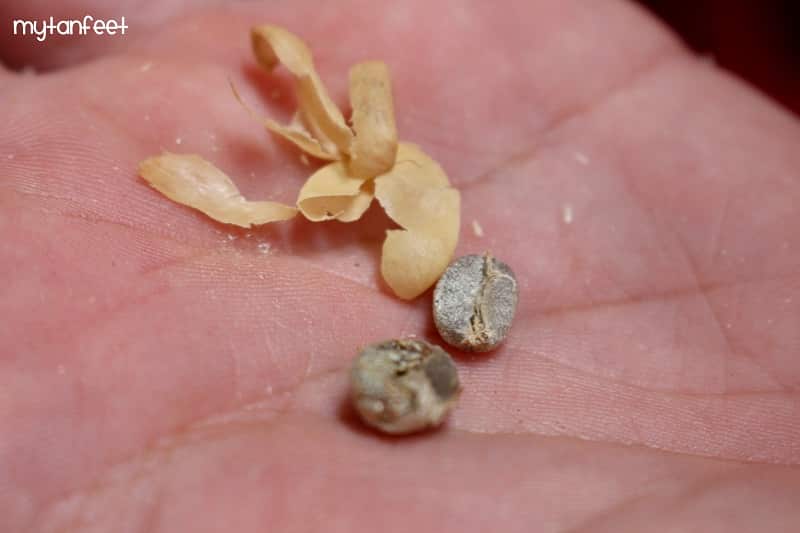
Roasting
After this, Doka sends out the coffee to various other companies to be exported or roasted.
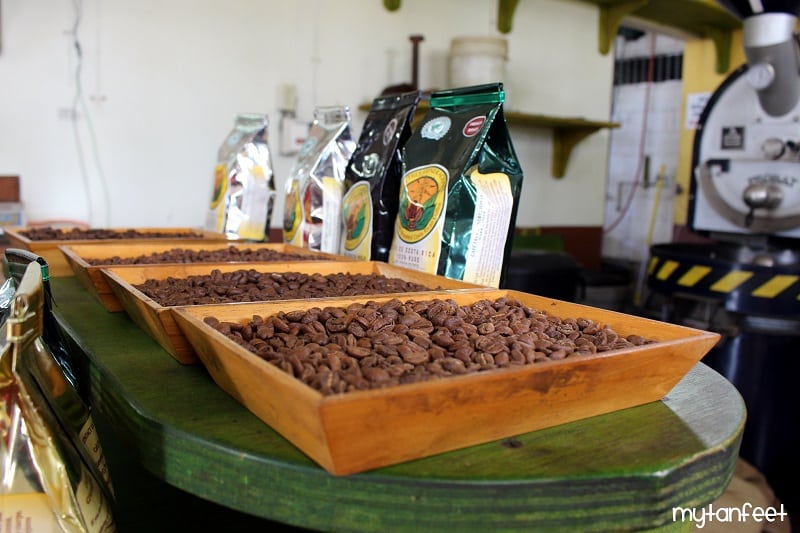
Purchasing Coffee
You can purchase coffee from the plantation and if you want to bring back coffee for souvenirs, I highly recommend buying it there. It is fresher and cheaper as you cannot readily find Doka Coffee at supermarkets outside the plantation.
One bag of coffee costs starting at $10 USD. They have both whole beans and ground coffee.
Doka Coffee Tour Review
Our knowledgeable guide made the tour very fun but educational at the same time. He used to be a coffee picker so he knows all the ins and outs of the procedure.
Learning the process of how something comes about is always an enlightening experience. We don’t think too much about it since we buy it from the grocery store, turn on the coffee maker and it ends there. In reality, it is a long process and it takes many workers to support the giant coffee addiction our world has.
Doka Coffee Tours from San Jose
If you have a car, you can drive to Doka Coffee Estate and take the coffee tour at the plantation. I recommend making reservations as it can get full quickly in high season (December through April). They run tours 5 times a day Mon – Fri and 4 times a day on the weekends. The Doka Estate Coffee Tour price is $18 – $65 per person depending on the package you get.
San Jose Day Tour
If you’re staying in San Jose and would like to do a tour with roundtrip transportation included, a very popular day tour from San Jose is the Doka Coffee Tour, Poas Volcano National Park and La Paz waterfall gardens.
We have done this day trip twice and it’s a fantastic experience to see three things Costa Rica is famous for: coffee, nature and wildlife. This tour includes breakfast, lunch, transportation, bilingual guide and entrance fees.
If you would like to book this Coffee Tour with La Paz and/or Poas Volcano, we offer small discounts for this tour and many other San Jose day tours. You can click the link San Jose day tours discount to book with our discount!
You can watch a video of this tour below.
This tour picked up in San Jose, went to Doka Coffee Estate first for the coffee tour and breakfast, then Poas Volcano National Park and then La Paz waterfall gardens which is where lunch is.
Interested in other day trips from San Jose? Click the link to see our most recommended day excursions from the capital city.
San Jose Hotels
Need a hotel in San Jose? We personally recommend KC Hotel, AC Hotel San Jose Escazu, Hotel Barcelo, Hotel Presidente, Hotel Palma Real, Park Inn by Radisson and Hotel Grano de Oro. Tour companies can pick up and drop off directly from those hotels.
Costa Rica Vacation Checklist
- First time to Costa Rica? Read our First Time in Costa Rica guide.
- Not sure how to move around Costa Rica? Read our How to Get Around Costa Rica guide to find the best transportation method for you.
- Click the link to get our detailed Costa Rica Packing List so you know what essential items to bring.
- Check our Costa Rica destinations map and Costa Rica restaurant map
- Do not forget to purchase Travel Insurance for your trip to Costa Rica.
- Stay connected by purchasing a prepaid SIM Card in Costa Rica.
- Save money with Mytanfeet Deals for tours and hotels and our Costa Rica Car Rental Discount.
Join our mailing list and get our free Costa Rica eBook!
Read about more fun things to do in San Jose, Costa Rica!
Pacuare White water rafting (Get $5 off)
Tortuga island day cruise (Get $10 Off)

Hauser says
You can buy doka coffee at the SJO airport for 15usd per bag as of this writing
Diana says
Hi! How long does the tour take please?
Sammi says
It’s a couple of hours
Joanna says
Want to stop here for a tour on the way to our hotel, would it be safe to have our luggage hidden in the trunk of the car? Is there security in the parking area?
Sammi says
Hi Joanna, I’m not positive if they have a security guard but they have the parking inside their property and there are always people going in and out.
Lorraine says
Do you pick up from the Costa Rica Marriott Hotel Hacienda Belen?
yeison says
Hello Lorraine,
Our partners at Expediciones Tropicales does pick up at the Marriott Hotel in Belen you can book this tour by clicking here.
Felicia Murrell says
We’re not planning to rent a car, but very interested in this tour. Will be staying in Playa del Cocos for the week. Is there another method of transportation to get there besides having to rent a car?
Sammi says
Doka is about a 4-4.5 hour drive from Coco so it’s not possible to do in a day, the best way would be to stay a night in the Alajuela/San Jose area.
Vicki L Smith-Jones says
Is there a plantation closer to Liberia that you would recommend? We will be staying at Playa Hermosa and I would very much like to take my family to a plantation as a day trip. Thank you,
Sammi says
Hi Vicki! Hmm honestly, because coffee grows best at high elevations, you will need to drive to get to a plantation. There are coffee tours in Liberia but they don’t have the plantation since they are at sea level so Guanacaste is not a good place for coffee. Monteverde is a great place for coffee and you’ll find some in Naranjo area on the way to La Fortuna as well.
Hannah says
fun read! I used to work at a coffee shop and Costa Rican coffee was VERY popular for sure!
Sammi says
Oh yeah! I always see them selling it in specialty coffee shops. Soo good!
Sand In My Suitcase says
We don’t need to be sold on Costa Rican coffee! We’re already there! This looks like a great tour 🙂
Sammi says
It was! So educational and informative. Plus great coffee 🙂
Irene (Lists-of-Lists) says
It is just for one cup. I like it strong. However, when you make coffee this way and use good coffee, it does not taste bitter at all.
Sammi says
It tastes pretty bitter to me! Depends on what kind you get. Peaberry was too light and citrusy for me. The espresso was nicely strong and dark.
Kristina says
Have not visited Costa Rica yet, but this blog post was quite informative and interesting. Would you suggest Costa Rica as a good honeymoon destination?
Sammi says
Absolutely! There are some gorgeous beaches here and many spots for an intimate getaway whether you just want to relax or go on adventures.
Bente Vold Klausen says
Costa Rica sounds and looks so exotic. As a coffee lover I appreciate good and strong flavor in my coffee as I believe this coffee has. I think I will try your Costa Rica guide as well!
Sammi says
It is unbelievably delicious! I love a stronger flavor too
SJ @ Chasing the Donkey says
Hmmmmmmmm coffee!!! I love coffee, and I’d so love to do this. By the way super photos!
Sammi says
Thanks SJ! I love coffee too so this tour was a good fit 🙂
Simone says
We love doing coffee tours! Our favorite was a plantation in Bali that specialized in “Cat Poo” coffee. Odd, but really good and a fascinating process.
Sammi says
Cat poo! Is that the one where the cat eats the seed and they make coffee out of the berry it poos out? Crazy!
Rachel@safari254 says
Picking coffee is hard work, I should know coz my grandmother grows coffee. 18 baskets a day! I think I can only manage 2 🙂 Interesting post, it brought back memories of my childhood, helping out in the coffee farm during the holidays.
Sammi says
I think I could probably only pick 2 too! It’s really tough work, not as easy as people think. I know coffee is a big deal over there too, I’d love to visit a farm one day to see the differences!
Lindsey Monge says
Wow this sounds like a great experience! A lot of people should see this process so they know what hard work goes into each cup of coffee 🙂
Sammi says
I absolutely agree! It’s not an easy process and us coffee drinkers take it for granted. It was great to learn more about it!